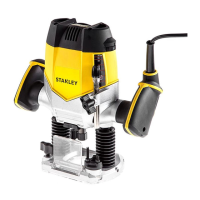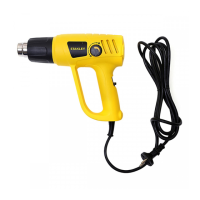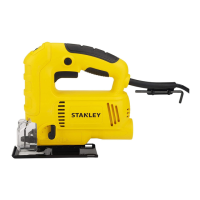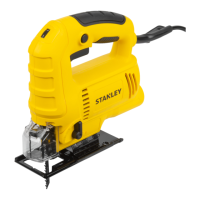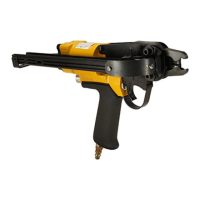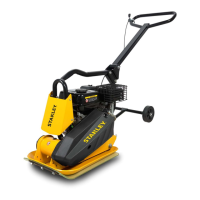18 • ENGLISH
FITTING THE EDGE GUIDE (FIG. C)
The edge guide helps to guide the tool parallel to an edge.
f Fit the bars (14) to the edge guide (15) using the two
screws (16) provided.
f Insert the bars (14) into the router base as shown.
f Set the edge guide to the required distance.
f Tighten the fixing screws (17).
FITTING THE DUST EXTRACTION ADAPTOR
(FIG. D)
The dust extraction adaptor allows you to connect a
vacuum cleaner to the tool.
f Connect the hose (18) of the vacuum cleaner to the
adaptor (11).
FITTING THE TEMPLATE GUIDE (FIG. E)
(Template guide not included)
f Fit the template guide (19) to the base of the router,
with the flange to the bottom (workpiece) side.
f Insert the two long screws (20) from the bottom side
through the template guide and the holes in the base.
f Place a nut onto each of the screws and securely
tighten the nuts.
FITTING THE DISTANCE PIECE (FIG. F)
(Distance piece not included)
f Fit the distance piece (21) to the base of the router
using the screws provided.
FITTING THE CENTRING PIN (FIG. G)
(Centring pin not included)
f Fit the edge guide to the router as shown in FIG. C,
but upside down.
f Fit the centring pin (22) to the workpiece side of the
edge guide with the screw (23) provided.
FITTING THE COPY FOLLOWER (FIG. H)
(Copy follower not included)
f Fit the edge guide to the router as shown in FIG. C.
f Fit the ‘L’ bar (24) to the upper side of the edge guide
using the two screws and nuts provided.
f Adjust the rotating attachment (25) on the ‘L’ bar with
the wing knob (26).
USE
Warning! Let the tool work at its own pace. Do not
overload.
f Carefully guide the cable in order to avoid accidentally
cutting it.
ADJUSTING THE DEPTH OF CUT (FIG. I, J and K)
f The depth of cut is the distance X between the depth
stop bar (9) and the depth stop (27).
f The depth of cut can be set in two different ways as
described below.
ADJUSTING THE DEPTH OF CUT USING THE
SCALE (FIG. J)
f Fit the router bit as described above.
f Loosen the locking screw (28).
f Pull the plunge lock lever (4) up.
f Plunge the router down until the router bit touches the
workpiece.
f Push the plunge lock lever (4) down.
f Move the pointer (29) in the zero position on the
scale (10).
f Add the desired depth of cut to the starting position.
f Move the depth stop bar (9) to the calculated position
on the scale.
f Tighten the locking screw (28).
f Fine adjust using the adjusting knob (30).
f Pull the plunge lock lever (4) up and let the router
return to its original position.
f After switching the router on, plunge it down and make
the desired cut.
ADJUSTING THE DEPTH OF CUT USING A
PIECE OF WOOD (FIG. K)
f Fit the router bit and plunge the router down as
described above.
f Pull the depth stop bar (9) up.
f Place a piece of wood with a thickness equal to the
desired depth of cut between the depth stop (27) and
the depth stop bar (9).
f Tighten the locking screw (28).
f Fine adjust using the adjusting knob (30).
f Remove the piece of wood.
f Pull the plunge lock lever (4) up and let the router
return to its original position.
f After switching the router on, plunge it down and make
the desired cut.
ADJUSTING THE REVOLVER DEPTH STOP (FIG. L)
After turning the revolver depth stop to the desired setting,
you can fine-adjust the depth stop to be used. If you want
to make several cuts with a different depth of cut, adjust
each of the depth stops.
f Turn the depth stop screw (31) up or down as required
using a screwdriver.
SETTING THE SPEED
f Set the speed control knob (3) to the required speed.
Use a high speed for small diameter router bits. Use a
low speed for large diameter router bits.
FITTING THE DUST EXTRACTION ADAPTOR
(FIG. M)
When it is not possible to use the edge guide, for example
when routing grooves in the back panel of a bookcase to
support shelves, proceed as follows:
